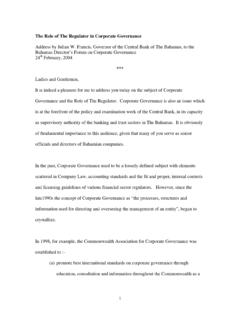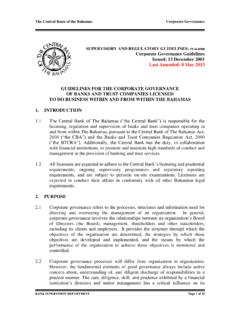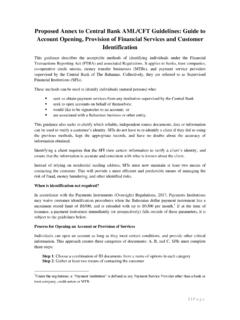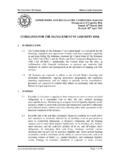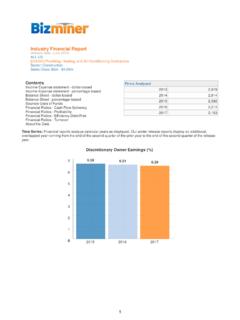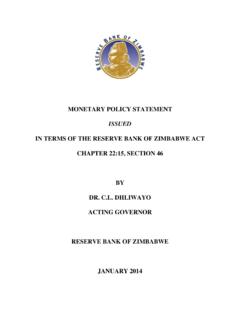Transcription of credit risk guidelines final 16.10.03 - Central Bank of ...
1 The Central Bank of The Bahamas credit Risk Management supervisory AND regulatory guidelines : 2003-05. credit Risk Management 16th October, 2003. guidelines FOR THE. MANAGEMENT OF credit RISK. I. INTRODUCTION. The Central Bank of The Bahamas ( the Central Bank ) is responsible for the licensing, regulation and supervision of banks and trust companies operating in and from within The Bahamas pursuant to The Banks and Trust Companies Regulation Act, 2000, and The Central Bank of The Bahamas Act, 2000. Additionally, The Central Bank has the duty, in collaboration with financial institutions, to promote and maintain high standards of conduct and management in the provision of banking and trust services. All licensees are expected to adhere to the Central Bank's licensing and prudential requirements and ongoing supervisory programmes, including periodic on-site inspections, and required regulatory reporting.
2 Licensees are also expected to conduct their affairs in conformity with all other Bahamian legal requirements. II. DEFINITIONS. credit is the provision of funds on agreed terms and conditions to a debtor who is obliged to repay the amount borrowed (together with interest thereon). credit may be extended, on a secured or unsecured basis, by way of instruments such as mortgages, bonds, consumer and corporate advances, financial derivatives and finance leases. credit risk is the risk of financial loss, despite realization of collateral, security or property, resulting from the failure of a debtor to honour its obligations to the licensee. credit risk management is the process of controlling the impact of credit risk-related events on the licensee. This management involves identification, understanding, and quantification of the degree of potential loss and the consequent taking of appropriate measures to minimise the risk of loss to the licensee.
3 III. PURPOSE. These guidelines specifically address the management of the credit risk present in the business activities of licensees, within their overall corporate governance process and risk management programme. The effective management of credit risk as a component of a comprehensive risk management programme is fundamental to the safety and soundness BANK SUPERVISION DEPARTMENT 16 th October, 2003 1. The Central Bank of The Bahamas credit Risk Management of every licensee and is critical to its long-term viability. These guidelines should be read in conjunction with the guidelines for the Corporate Governance of Banks and Trust Companies Licensed to do Business Within and From Within The Bahamas . ( Corporate Governance guidelines ) and the guidelines for the Management of Large Exposures ( Large Exposures guidelines ).
4 Additionally, the Central Bank endorses the Basel Committee's 17 Principles for Management of credit Risk (September 2000) (See Appendix 1). Banks are encouraged to refer to the full Basel document at Experience indicates that adherence to sound credit granting policies and procedures goes hand in hand with financial soundness. Failure to adopt and adhere to sound credit policies and procedures is often a source of weakness in financial institutions. The major consequence, which arises from a weakening of the credit risk portfolio is the impairment of capital or liquidity, or both. credit risk management should be conducted within the context of a comprehensive business plan. Although these guidelines focus on a licensee's responsibility for managing and controlling its investments and loan portfolio and exposure to credit risk, it is not meant to imply that credit risk can be managed in isolation from other considerations such as asset/liability management considerations and the need to maintain adequate liquidity.
5 IV. APPLICABILITY. These guidelines apply, as appropriate, to all licensees that engage in business activities that produce credit risk. They represent the Central Bank's identification of accepted best practices for effective credit risk management in licensees. The Central Bank appreciates that the breadth of the credit risk management programme in each licensee will depend on the scope and sophistication of the activities of the licensee, the nature and complexity of its credit -related businesses, and the types and levels of the risks that it assumes. However, failure to adopt a satisfactory credit risk management programme appropriate to its business activities constitutes an unsafe and unsound practice and could subject the licensee to regulatory sanctions. As part of its ongoing off-site supervision and on-site examination and analysis programmes, the Central Bank will periodically conduct an evaluation of each licensee's strategies, policies, procedures and the management of the business activities that generate credit and related risks ( , the credit risk management programme).
6 The Central Bank's Regulations and guidelines establish the standards against which each licensee's credit risk management programme will be evaluated. BANK SUPERVISION DEPARTMENT 16 th October, 2003 2. The Central Bank of The Bahamas credit Risk Management V. ESTABLISHING A credit RISK ENVIRONMENT. Sound credit management involves establishing a credit risk philosophy, and policies and procedures for prudently managing the risk/reward relationship across a variety of dimensions, such as quality, concentration, maturity, currency, collateral security or property and type of credit facility. 1. credit Risk Strategy and Policy Licensees should have a written statement of their credit risk strategy and policy to implement the strategy. The strategy and policy should be approved by the board of directors and should be consistent with the licensee's degree of risk tolerance, the level of capital available for credit activities and credit management expertise.
7 The board should review the strategy and policy periodically (at least annually) to ensure their adequacy and relevance given the changing operating circumstances, economic cycles, activities and risks that the licensee may face. The credit risk strategy and policy should be clearly disseminated to, and understood by, all relevant staff. 2. Risk Tolerance and Portfolio Limits Licensees should clearly articulate their credit risk tolerance, including how much, and what types of risk they are prepared to undertake. Risk tolerance should be compatible with the licensee's overall strategic objectives. The credit risk policy should specify, inter-alia: (a) Types of facilities to be offered, along with pricing policies, profitability targets, maximum maturities and maximum debt-servicing ratios borrowers for each type of lending.
8 (b) A ceiling for the total loan portfolio ratios ( , for loan to deposit ratio, maximum dollar amount or a percentage of capital base);. (c) Portfolio limits for maximum aggregate exposures by country, industry, category of borrower/ counterparty, individual credit product, groups of related parties and single borrowers, etc.;. (d) Limits, terms and conditions, approval and review procedures and records kept for connected lending;. (e) Types of acceptable collateral ( , charges, pledges, cash, securities, credit derivatives), loan-to-value ratios and the criteria for accepting guarantees; and (f) The minimum information required from loan applicants (bearing in mind AML and KYC best practice and legal requirements). BANK SUPERVISION DEPARTMENT 16 th October, 2003 3. The Central Bank of The Bahamas credit Risk Management 3.
9 Risk Concentrations Licensees should establish internal controls and systems, endorsed by the board of directors, to measure, monitor and control large exposures and other risk concentrations in accordance with the Central Bank's Large Exposures Re gulations and guidelines . Licensees should establish the proper mechanisms to ensure timely and accurate regulatory pre- notification and reporting. 4. New Products Licensees should recognise and control the credit risk arising from their services and activities, including the risks associated with new products. Before licensees enter into new types of products, activities or markets, they should ensure that they understand and assess the impact of the possible risks to be undertaken with a view of minimizing the downside potential of the inherent risks associated with the introduction of the new product or service.
10 They should decide whether such products, activities or markets are consistent with their strategy, and if so, they should establish appropriate credit risk policies, procedures and controls, which should be approved by the board of directors or its appropriate delegated committee. The required formal risk assessment of new products and activities should be documented. 5. Delegated credit Authority credit authority should be clearly delegated by the board of directors and should be appropriate for the products or portfolios assigned to the credit Committee or individual credit officers and should be commensurate with their credit experience and expertise. Licensees should ensure that credit authority is required and designated for all types of credit exposures, including the use of credit derivatives for hedging or income generation.
